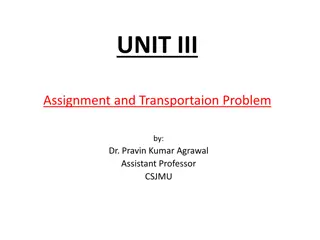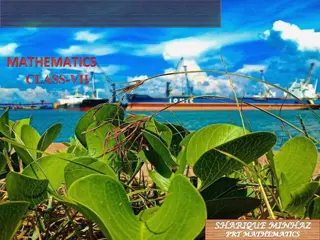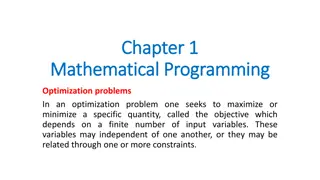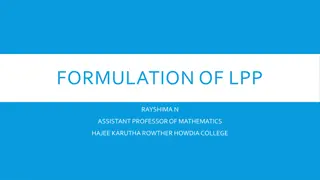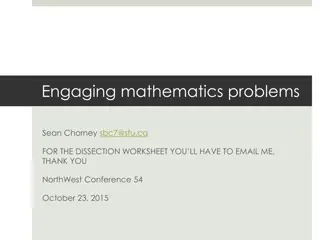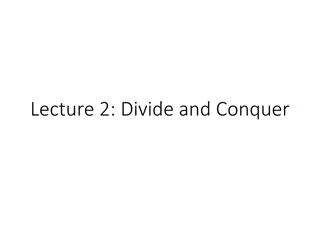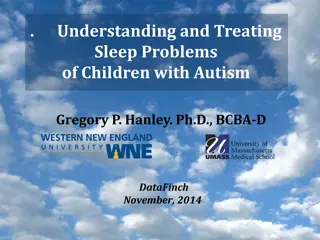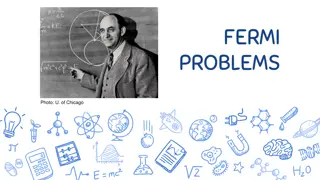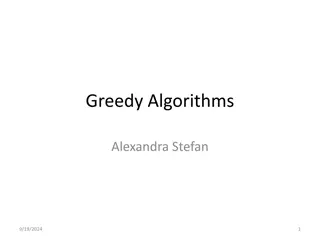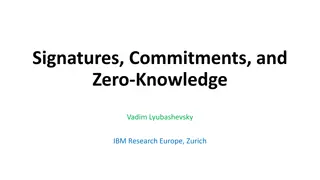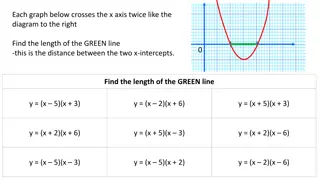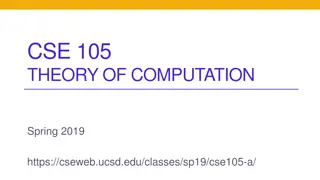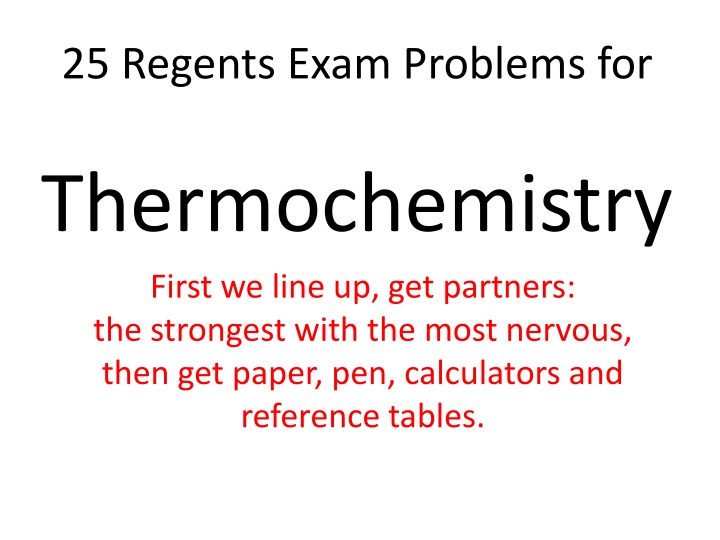
Thermochemistry Regents Exam Problems and Solutions August & June 2007
Practice solving Regents exam problems related to thermochemistry involving energy changes in reactions, bond formation, temperature changes, and phase transitions. Questions cover topics like energy absorption, bond breaking, melting, and elements in different states at STP. Get detailed explanations for each question.
Download Presentation

Please find below an Image/Link to download the presentation.
The content on the website is provided AS IS for your information and personal use only. It may not be sold, licensed, or shared on other websites without obtaining consent from the author. If you encounter any issues during the download, it is possible that the publisher has removed the file from their server.
You are allowed to download the files provided on this website for personal or commercial use, subject to the condition that they are used lawfully. All files are the property of their respective owners.
The content on the website is provided AS IS for your information and personal use only. It may not be sold, licensed, or shared on other websites without obtaining consent from the author.
E N D
Presentation Transcript
25 Regents Exam Problems for Thermochemistry First we line up, get partners: the strongest with the most nervous, then get paper, pen, calculators and reference tables.
August 2007 1. Given this balanced equation representing a reaction: Cl2(G) Cl(G) + Cl(G) What occurs during this change? A. energy is absorbed and a bond is broken B. energy is absorbed and a bond is formed C. energy is released and a bond is broken D. energy is released and a bond is formed
August 2007 1. Given this balanced equation representing a reaction: Cl2(G) Cl(G) + Cl(G) What occurs during this change? A. energy is absorbed and a bond is broken
June 2007 2. Given the balanced equation: I + I I2 Which statement describes the process represented by this equation? A. A bond is formed as energy is absorbed B. A bond is formed as energy is released C. A bond is broken as energy is absorbed D. A bond is broken as energy is released
June 2007 2. Given the balanced equation: I + I I2 Which statement describes the process represented by this equation? B. A bond is formed as energy is released
The temperature of a sample is increased from 20.C to 160.centigrade as the sample absorbs heat at a constant rate of 15 kilojoules per minute at standard pressure. The graph below represents the relationship between temperature and time as the sample is heated. 3. What is the boiling point of the sample? 4. What is the total time the sample is in the liquid phase? 5. Determine the amount of energy in Joules needed to melt the sample.
3. What is the boiling point of the sample? 120C 4. What is the total time the sample is in the liquid phase? 7 4 = 3 minutes 5. Determine the amount of energy in Joules needed to melt the sample. This is NOT a q = mHF Rather, 15 kJ/minute X 2 minutes = 30 kJ = 30,000 J
January 2007 Regents exam 6. At STP, which list of elements contains a solid, liquid, and a gas? A. Ba, Br2, B B. Cr, Cl2, C C. Hf, Hg, He D. Se, Sn, Sr
January 2007 Regents exam 6. At STP, which list of elements contains a solid, liquid, and a gas? A. Ba, Br2, B B. Cr, Cl2, C C. Hf, Hg, He D. Se, Sn, Sr
January 2007 Regents exam 7. At which temperature would atoms of He(G) have the highest kinetic energy? A. 25 C B. 37 C C. 273K D. 298K
January 2007 Regents exam 7. At which temperature would atoms of He(G) have the highest kinetic energy? A. 25 C B. 37 C C. 273K D. 298K A and C are both colder (lower KE) than B and D. Which is HOTTER? Convert 37 C into K K = C + 273 K = 37 + 273 K = 310 37 C = 310 K, so 37 C is hottest, and has highest KE
January 2007 Regents exam 8. The balanced equation below represents a molecule of bromine separating into two bromine atoms. Br2 Br + Br What occurs during this change? A. energy is absorbed and a bond is formed B. energy is absorbed and a bond is broken C. energy is released and a bond is formed D. energy is released and a bond is broken
January 2007 Regents exam 8. The balanced equation below represents a molecule of bromine separating into two bromine atoms. Br2 Br + Br What occurs during this change? B. energy is absorbed and a bond is broken
January 2007 Regents exam 9. Given the balanced reaction as N2(G) + 3H2(G) 2NH3(G) + 91.8 kJ Which statement is true about that reaction? A. It is exothermic and the H = -91.8 kJ B. It is exothermic and the H = +91.8 kJ C. It is endothermic and the H = -91.8 kJ D. It is endothermic and the H = +91.8 kJ
January 2007 Regents exam 9. Given the balanced reaction as N2(G) + 3H2(G) 2NH3(G) + 91.8 kJ Which statement is true about that reaction? A. It is exothermic and the H = -91.8 kJ Just look at table I. If you ever get confused on thermo, just say to yourself, I wonder what I should do now? Maybe it will come to you if you think hard!
Physical constants for NH3(L) heat of fusion 332 J/g heat of vaporization 1370 J/g specific heat capacity 4.71 J/g K A 5.00 gram sample of liquid ammonia is originally at 210 K. The diagram of the partial heating curve above represents the vaporization of the sample at standard pressure due to the addition of heat. The heat is not added at a constant rate. 10. Calculate the total heat absorbed by the 5.00 gram sample during time interval AB. Your response must show a numerical set up + a calculated result.
10. Calculate the total heat absorbed by the 5.00 g sample during time interval AB. Your response must show a numerical set up and a calculated result. This is warming up of a liquid, not melting or vaporizing. Use q = mC T q = (5.00g)(4.71g/J K)(30.K) q = 706.5 J = 710 J 2SF
Continue with same graph on same regents exam Describe what is happening to both the potential energy and the average kinetic energy of the molecules during BC. Your response must include both potential and average kinetic energy. Also state phases present during BC interval. 11A. POTENTIAL ENERGY: ________________________ 11B. KINETIC ENERGY: ___________________________ 12. PHASE/PHASES PRESENT: ____________________
Continue with same graph on same regents exam Describe what is happening to both the potential energy and the average kinetic energy of the molecules during BC. Your response must include both potential and average kinetic energy. Also state phases present during BC interval. 11A. POTENTIAL ENERGY: INCREASING 11B. KINETIC ENERGY: STEADY 12. PHASE/PHASES PRESENT: LIQUID TO GAS
Do Not do the math, just tell how many SF the answer should have, and what formulas to use. 14. How much energy is required to melt 23.45 grams of ice at 0 C into water at the same temperature? 15. How many kilojoules of energy is needed to convert H2O at 35.6 C into steam at 100.0 C? 16. How many joules of energy does it take to change 245.7 grams of water at 5.00 C into frozen ice at 0 C? 17. Is question number sixteen an exo or endothermic process?
Do Not do the math, just tell what formulas to use. 14. How much energy is required to melt 23.45 grams of ice at 0 C into water at the same temperature? 4 SF q = mHF 15. How many kilojoules of energy is needed to convert H2O at 35.6 C into steam at 100.0 C? 3 SF q = mC T and q = mHV 16. How many joules of energy does it take to change 245.7 grams of water at 5.00 C into frozen ice at 0 C? 3 SF q = mC T and q = mHF 17. Is question number sixteen an exo or endothermic process? It s exothermic, heat is removed as a product to freeze.
18. When you add 12,501 joules to 125.0 g of copper. The copper temperature changes from an original 293.0 K to a new temperature. What temperature is it after getting these joules? (the C of Cu = 0.39 J/g K)
18. When you add 12,501 joules to 125.0 g of copper. The copper temperature changes from an original 293.0 K to a new temperature. What temperature is it after getting these joules? (the C of Cu = 0.39 J/g K) q = mC T 12501 J = (125.0g)(0.39J/g K)( T) 256.4 K = T (4SF) Start temp is = 293.0 K It s heating up, so ADD the T + 256.4 K 549.4 K(4SF)
Draw a cooling curve for IRON. Indicate the proper temperatures in Kelvin, then label the points from the left to right ABCDE and F.
Draw a cooling curve for IRON. Indicate the proper temperatures in Kelvin, then label the points from the left to right ABCDE and F. A Cooling curve for Iron 3134 K B C E 1811 K D F Energy removed at a constant rate
19. What formula is used to move from point B to C 20. from C to D 21. from E to F 22. Is kinetic energy increasing, decreasing, or holding steady at segment BC? 23. Is potential energy increasing, decreasing, or holding steady at segment CD? 24. Is kinetic energy increasing, decreasing, or holding steady at segment EF? 25. Moving from point C to D would be called exothermic or endothermic? A Cooling curve for Iron 3134 K B C E 1811 K D F Energy removed at a constant rate
19, 20, and 21. See the formulas below. 22. Kinetic energy is STEADY on segment BC. 23. Potential energy is STEADY at segment CD. 24. Kinetic energy is DECREASING at segment EF. 25. Moving from point C to D is exothermic because energy is REMOVED TO COOL the iron. A Cooling curve for Iron q= mC T 3134 K C q= mHV B q= mC T E 1811 K D F Energy removed at a constant rate



